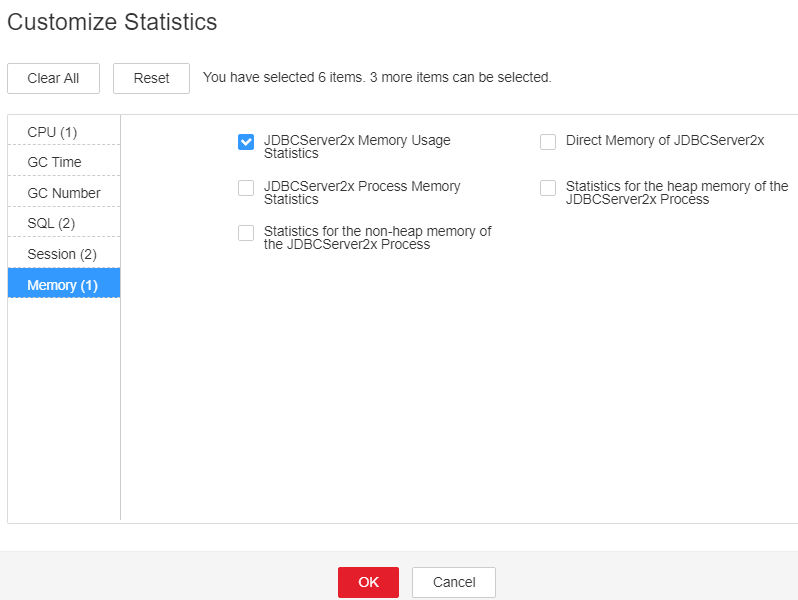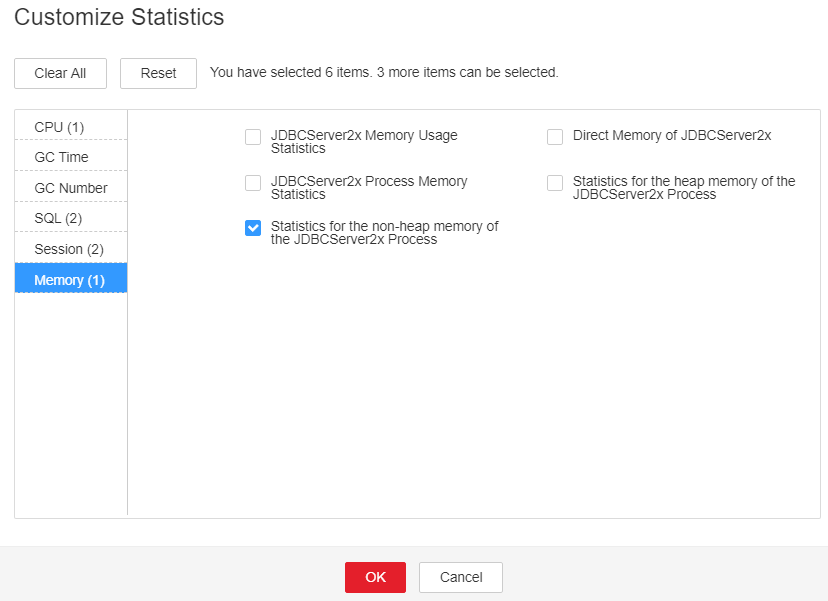ALM-43011 Non-Heap Memory Usage of the JDBCServer2x Process Exceeds the Threshold
Description
The system checks the JDBCServer2x Process status every 30 seconds. The alarm is generated when the non-heap memory usage of an JDBCServer2x Process exceeds the threshold (95% of the maximum memory).

In MRS 3.3.0-LTS and later versions, the Spark2x component is renamed Spark, and the role names in the component are also changed. For example, JDBCServer2x is changed to JDBCServer. Refer to the descriptions and operations related to the component name and role names in the document based on your MRS version.
Attribute
|
Alarm ID |
Alarm Severity |
Auto Clear |
|---|---|---|
|
43011 |
Major |
Yes |
Parameters
|
Name |
Meaning |
|---|---|
|
Source |
Specifies the cluster for which the alarm is generated. |
|
ServiceName |
Specifies the service name for which the alarm is generated. |
|
RoleName |
Specifies the role name for which the alarm is generated. |
|
HostName |
Specifies the object (host ID) for which the alarm is generated. |
|
Trigger Condition |
Specifies the threshold triggering the alarm. If the current indicator value exceeds this threshold, the alarm is generated. |
Impact on the System
If the non-heap memory usage of the JDBCServer2x process is too high, the performance deteriorates, and even memory overflow occurs. As a result, the JDBCServer2x process is unavailable, and Spark JDBC tasks are slow or fail to run.
Possible Causes
The non-heap memory of the JDBCServer2x Process is overused or the non-heap memory is inappropriately allocated.
Procedure
Check non-heap memory usage.
- On the FusionInsight Manager portal, choose O&M > Alarm > Alarms and select the alarm whose ID is 43011. Check the RoleName in Location and confirm the IP address of HostName.
- On the FusionInsight Manager portal, choose Cluster > Services > Spark2x > Instance and click the JDBCServer2x for which the alarm is generated to go to the Dashboard page. Click the drop-down menu in the Chart area and choose Customize > Memory > JDBCServer2x Memory Usage Statistics from the drop-down list box in the upper right corner and click OK, Check whether the used non-heap memory of the JDBCServer2x Process reaches the threshold (default value is 95%) of the maximum non-heap memory specified for JDBCServer2x.
Figure 1 JDBCServer2x Memory Usage Statistics

- On the FusionInsight Manager home page, choose Cluster > Services > Spark2x > Instance. Click JDBCServer2x by which the alarm is reported to go to the Dashboard page, click the drop-down list in the upper right corner of the chart area, choose Customize > Memory > Statistics for the non-heap memory of the JDBCServer2x Process, and click OK. Based on the alarm generation time, check the values of the used non-heap memory of the JDBCServer2x process in the corresponding period and obtain the maximum value.
Figure 2 Statistics for the non-heap memory of the JDBCServer2x Process

- On the FusionInsight Manager portal, choose Cluster > Services > Spark2x > Configurations, and click All Configurations. Choose JDBCServer2x > Tuning. You can change the value of -XX: MaxMetaspaceSize in spark.driver.extraJavaOptions according to the following rules: Ratio of the JDBCServer2x non-heap memory usage to the Threshold of JDBCServer2x Non-Heap Memory Usage Statistics (JDBCServer2x) in the alarm period.

On the FusionInsight Manager home page, choose O&M > Alarm > Thresholds > Spark2x > Memory > JDBCServer2x Non-Heap Memory Usage Statistics (JDBCServer2x) to view Threshold.
- Restart all JDBCServer2x instances.

When the instance is rebooted, it cannot be used and any tasks running on the current instance node will fail.
- After 10 minutes, check whether the alarm is cleared.
- If yes, no further action is required.
- If no, go to Step 7.
Collect fault information.
- On the FusionInsight Manager portal, choose O&M > Log >Download.
- Select Spark2x in the required cluster from the Service.
- Click
 in the upper right corner, and set Start Date and End Date for log collection to 10 minutes ahead of and after the alarm generation time, respectively. Then, click Download.
in the upper right corner, and set Start Date and End Date for log collection to 10 minutes ahead of and after the alarm generation time, respectively. Then, click Download. - Send the collected fault logs to O&M personnel for help.
Alarm Clearing
After the fault is rectified, the system automatically clears this alarm.
Related Information
None
Feedback
Was this page helpful?
Provide feedbackThank you very much for your feedback. We will continue working to improve the documentation.See the reply and handling status in My Cloud VOC.
For any further questions, feel free to contact us through the chatbot.
Chatbot





